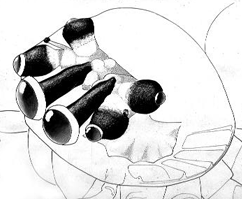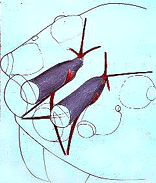Go to jumping spider anatomy page
Jumping spiders have excellent vision, with among the highest acuities in invertebrates. The eight eyes are grouped four on the face (the two big Anterior Median eyes in the middle, and two smaller Anterior Lateral eyes to the side), and four on top of the carapace (two medium-sized eyes toward the back, and two very small eyes in front of them). You can think of the Anterior Median eyes (AME) as acting like our fovea, with high acuity but small field of view, and the remaining six eyes acting like our peripheral vision, with lower resolution but broad field of view. If you were to open up the carapace of a jumping spider and view the brain and eyes, you would see something like this:


Note that the AME's are long and tubular, which helps their resolution (longer focal length, more magnification) but which means they have a narrow field of view. Since the AME's have a narrow field of view, the spider needs to point them in different directions to see different things. To some extent this is done by moving the carapace, but the eyes can move as well. This is not done by moving the whole 'eyeball', since the lenses of the eyes are actually built into the carapace. Instead the retina moves around, while the lens stays fixed. This retinal movement is accomplished by some small muscles:


Because the retina is the darkest part of the eye and it moves around, you can sometimes look into the eye of a jumping spider and see it changing color. When it is darkest, you know the spider is looking straight at you, because then you are looking down into its retina.
The brain of a jumping spider includes a comparatively large region
for visual processing. In fact, the brain of a small jumping spider
may take up about the same volume in proportion to its body as does
ours. (Of course, this doesn't mean jumping spiders are smarter than
we are, since the absolute size of the brain is what is more important.)
The brain is shown in blue in this picture:


Jumping spider anatomy pages:
[Anatomy] [External] [Muscles] [Gut] [Vision] [Palpi] [Epigyna] [Gallery]



 Go to quick links
Go to quick search
Go to navigation for this section of the ToL site
Go to detailed links for the ToL site
Go to quick links
Go to quick search
Go to navigation for this section of the ToL site
Go to detailed links for the ToL site